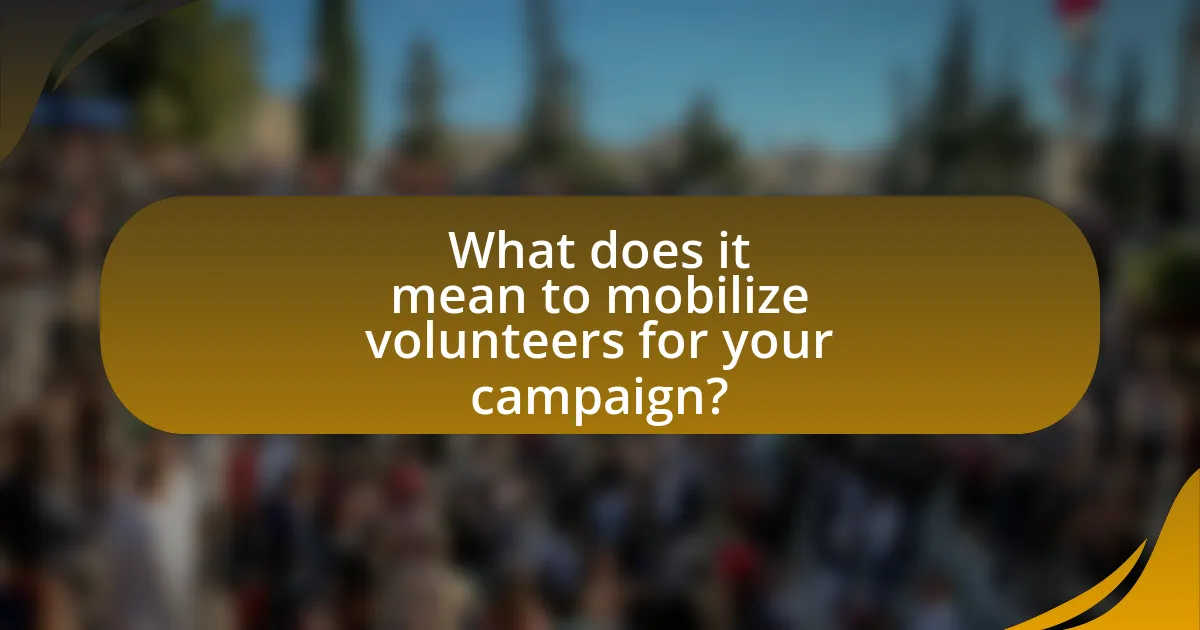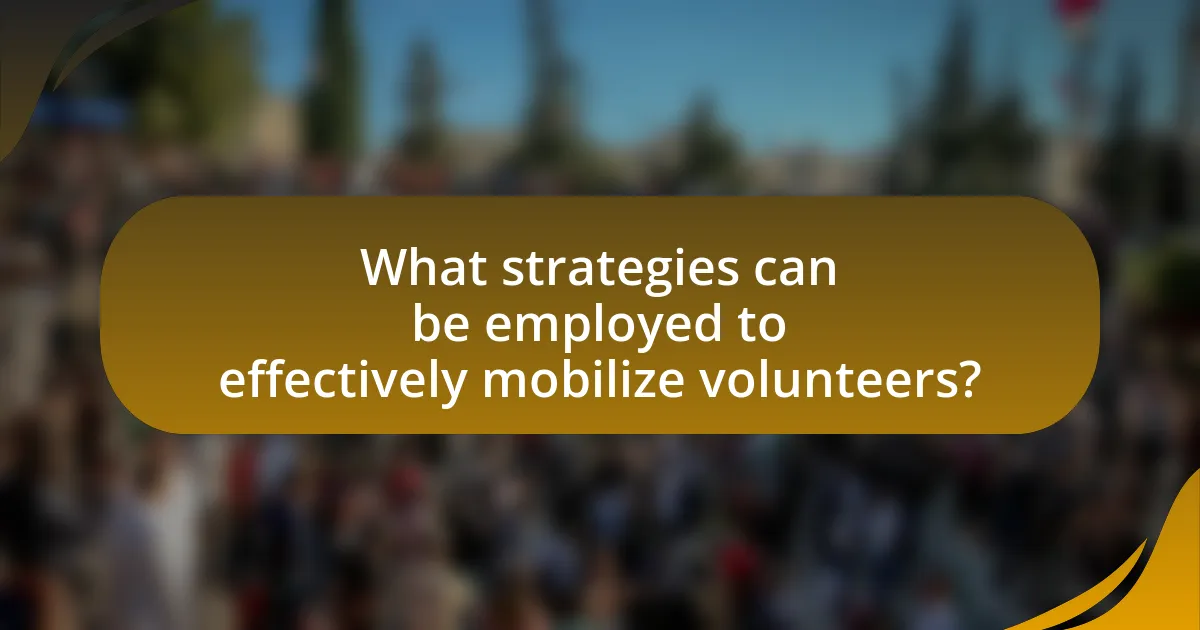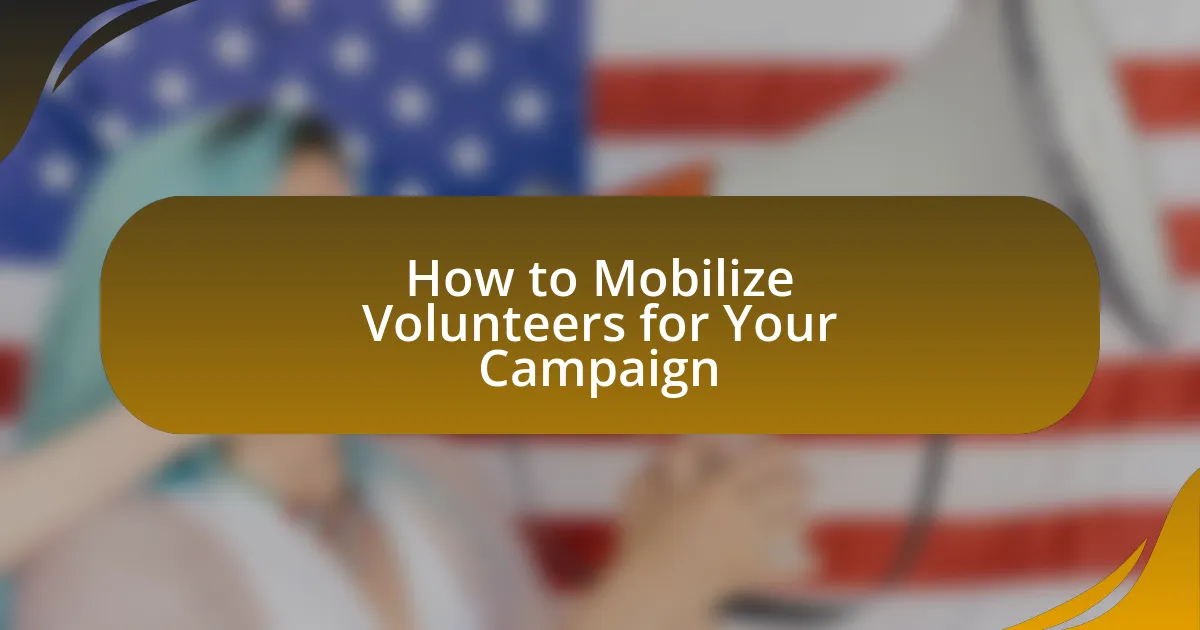Mobilizing volunteers for a campaign involves organizing and engaging individuals to participate in activities such as canvassing and event planning, which are crucial for increasing outreach and support. Understanding volunteer motivations—such as personal fulfillment and social connections—can enhance mobilization efforts by aligning campaign goals with these drivers. Effective strategies for volunteer mobilization include targeted recruitment, clear communication, and recognition programs, all of which contribute to increased engagement and retention. Additionally, training plays a vital role in equipping volunteers with necessary skills, while ongoing engagement practices help maintain volunteer loyalty and address challenges such as burnout and recruitment difficulties.

What does it mean to mobilize volunteers for your campaign?
Mobilizing volunteers for your campaign means organizing and engaging individuals to actively participate in campaign activities. This process involves recruiting, training, and coordinating volunteers to perform tasks such as canvassing, phone banking, and event planning, which are essential for increasing outreach and support. Effective mobilization can lead to a more energized and committed volunteer base, ultimately enhancing the campaign’s chances of success. Research shows that campaigns with strong volunteer mobilization efforts can increase voter turnout by as much as 10% (Gerber, Alan S., and Donald P. Green, “Get Out the Vote: How to Increase Voter Turnout,” 2008).
How can understanding volunteer motivation enhance mobilization efforts?
Understanding volunteer motivation enhances mobilization efforts by allowing organizations to tailor their outreach strategies to align with the interests and values of potential volunteers. When organizations recognize what drives individuals to volunteer—such as personal fulfillment, social connections, or a desire to contribute to a cause—they can create targeted messaging and opportunities that resonate with these motivations. For instance, research by the Corporation for National and Community Service indicates that volunteers are more likely to engage when they see a clear connection between their skills and the needs of the organization, demonstrating that aligning tasks with volunteer motivations can significantly increase participation rates.
What are the key factors that motivate individuals to volunteer?
Key factors that motivate individuals to volunteer include personal fulfillment, social connections, and a desire to make a difference. Personal fulfillment often stems from the satisfaction gained from helping others and contributing to a cause, which can enhance an individual’s sense of purpose. Social connections are significant as volunteering provides opportunities to meet new people and strengthen community ties, fostering a sense of belonging. Additionally, the desire to make a difference drives many volunteers, as they seek to address social issues and contribute positively to their communities. Research by the Corporation for National and Community Service indicates that individuals who volunteer report higher levels of happiness and life satisfaction, reinforcing the motivational factors of personal fulfillment and social engagement.
How can you align your campaign goals with volunteer motivations?
To align your campaign goals with volunteer motivations, you must first understand the intrinsic and extrinsic factors that drive volunteers. Research indicates that volunteers are motivated by personal values, social connections, and the desire to make a difference. By identifying these motivations, you can tailor your campaign goals to resonate with them. For instance, if volunteers are motivated by community impact, framing your campaign around local benefits can enhance engagement. Additionally, providing opportunities for skill development and recognition can further align their motivations with your campaign objectives, as studies show that volunteers are more likely to commit when they see personal growth and appreciation.
Why is volunteer mobilization crucial for campaign success?
Volunteer mobilization is crucial for campaign success because it significantly enhances the reach and impact of the campaign. Engaging volunteers allows campaigns to leverage grassroots support, which can lead to increased voter turnout and community engagement. For instance, studies have shown that campaigns utilizing volunteers can increase their outreach by up to 50%, as volunteers often have personal connections within their communities that can influence others. Additionally, mobilized volunteers can provide essential resources, such as time and skills, which are often more cost-effective than paid staff. This combination of increased outreach and resource efficiency directly contributes to a campaign’s overall effectiveness and success.
What impact do volunteers have on campaign outreach and effectiveness?
Volunteers significantly enhance campaign outreach and effectiveness by increasing manpower and fostering community engagement. Their involvement allows campaigns to reach a broader audience through grassroots efforts, such as door-to-door canvassing and local events. For instance, a study by the Harvard Kennedy School found that campaigns utilizing volunteers can increase voter turnout by up to 10%. This demonstrates that volunteers not only amplify the message but also create personal connections that resonate with potential supporters, ultimately leading to higher engagement and success rates in campaigns.
How does volunteer mobilization contribute to community engagement?
Volunteer mobilization enhances community engagement by actively involving individuals in local initiatives and fostering a sense of belonging. When volunteers participate in community projects, they build relationships with fellow residents, which strengthens social networks and encourages collaboration. Research indicates that communities with higher volunteer participation experience increased civic involvement and improved trust among residents, leading to more resilient and cohesive neighborhoods. For instance, a study by the Corporation for National and Community Service found that volunteering can lead to a 20% increase in community engagement metrics, demonstrating the direct impact of mobilized volunteers on community dynamics.

What strategies can be employed to effectively mobilize volunteers?
To effectively mobilize volunteers, organizations should implement targeted recruitment strategies, clear communication, and recognition programs. Targeted recruitment involves identifying specific demographics that align with the campaign’s goals, which can increase engagement; for instance, research shows that campaigns that tailor their outreach to specific community groups see a 30% increase in volunteer sign-ups. Clear communication ensures that potential volunteers understand their roles and the impact of their contributions, which can be facilitated through detailed informational sessions and engaging materials. Recognition programs, such as awards or public acknowledgments, can enhance volunteer retention and motivation, as studies indicate that 70% of volunteers are more likely to continue their involvement when they feel appreciated.
How can you identify and target potential volunteers?
To identify and target potential volunteers, organizations should analyze demographic data and community interests to find individuals likely to engage in volunteer activities. Utilizing surveys and social media analytics can reveal preferences and motivations, allowing for tailored outreach strategies. For instance, a study by the Corporation for National and Community Service found that individuals aged 35-44 are among the most active volunteers, indicating a target demographic for volunteer recruitment efforts. Additionally, leveraging local events and partnerships with community organizations can enhance visibility and attract potential volunteers who are already engaged in related activities.
What methods can be used to reach out to potential volunteers?
To reach out to potential volunteers, organizations can utilize social media campaigns, community events, and targeted email outreach. Social media platforms like Facebook and Instagram allow for broad engagement, enabling organizations to share their mission and volunteer opportunities effectively. Community events, such as local fairs or informational sessions, provide face-to-face interaction, fostering personal connections and encouraging sign-ups. Targeted email outreach can be effective by sending personalized messages to individuals who have previously shown interest in similar causes, increasing the likelihood of their participation. These methods are supported by studies indicating that personal engagement and targeted communication significantly enhance volunteer recruitment efforts.
How can social media be leveraged to attract volunteers?
Social media can be leveraged to attract volunteers by creating engaging content that highlights the mission and impact of the organization. By sharing compelling stories, testimonials, and visuals, organizations can connect emotionally with potential volunteers, making them more likely to participate. For instance, a study by the Pew Research Center found that 69% of adults in the U.S. use social media, providing a vast audience for outreach efforts. Additionally, targeted ads on platforms like Facebook and Instagram can reach specific demographics interested in volunteering, increasing the likelihood of attracting individuals who align with the organization’s values and goals.
What role does training play in volunteer mobilization?
Training plays a crucial role in volunteer mobilization by equipping volunteers with the necessary skills and knowledge to effectively contribute to a campaign. Well-structured training programs enhance volunteers’ confidence and competence, leading to increased engagement and productivity. For instance, a study by the Corporation for National and Community Service found that organizations that provided comprehensive training saw a 50% increase in volunteer retention rates. This demonstrates that effective training not only prepares volunteers for their roles but also fosters a sense of commitment and belonging, ultimately driving successful mobilization efforts.
How can effective training programs enhance volunteer performance?
Effective training programs enhance volunteer performance by equipping volunteers with the necessary skills and knowledge to perform their tasks efficiently. When volunteers receive structured training, they gain a clear understanding of their roles, which leads to increased confidence and motivation. Research indicates that organizations with comprehensive training programs report a 50% increase in volunteer retention rates, demonstrating the direct correlation between training and performance. Furthermore, effective training fosters teamwork and communication among volunteers, which enhances collaboration and overall campaign success.
What are the essential skills volunteers should be trained in?
Volunteers should be trained in communication, teamwork, problem-solving, and leadership skills. Effective communication enables volunteers to convey messages clearly and engage with the community, which is crucial for campaign success. Teamwork fosters collaboration among volunteers, enhancing productivity and morale. Problem-solving skills equip volunteers to address challenges that arise during campaigns, ensuring adaptability and resilience. Leadership skills empower volunteers to take initiative and guide others, promoting a sense of ownership and responsibility within the campaign. These skills collectively enhance the effectiveness of volunteer efforts in mobilizing support for campaigns.

What are the best practices for maintaining volunteer engagement?
The best practices for maintaining volunteer engagement include regular communication, recognition of contributions, and providing meaningful roles. Regular communication ensures volunteers feel informed and connected to the organization’s mission, which can be achieved through newsletters, social media updates, and personal check-ins. Recognition of contributions, such as public acknowledgment or awards, fosters a sense of value and belonging among volunteers. Providing meaningful roles that align with volunteers’ skills and interests enhances their commitment and satisfaction, as studies show that engaged volunteers are more likely to continue their involvement and recommend the organization to others.
How can you create a positive volunteer experience?
To create a positive volunteer experience, organizations should provide clear communication and meaningful engagement opportunities. Clear communication ensures that volunteers understand their roles, expectations, and the impact of their contributions, which fosters a sense of purpose. Meaningful engagement involves assigning tasks that align with volunteers’ skills and interests, enhancing their satisfaction and commitment. Research indicates that organizations that prioritize volunteer satisfaction see a 50% increase in retention rates, demonstrating the importance of a positive experience in maintaining volunteer involvement.
What recognition and rewards can be offered to volunteers?
Recognition and rewards for volunteers can include certificates of appreciation, public acknowledgment in newsletters or social media, and small tokens of gratitude such as gift cards or branded merchandise. These forms of recognition not only validate the efforts of volunteers but also foster a sense of belonging and motivation. Research indicates that 70% of volunteers feel more engaged when their contributions are recognized, highlighting the importance of acknowledgment in volunteer retention and satisfaction.
How can regular communication foster volunteer loyalty?
Regular communication fosters volunteer loyalty by creating a sense of belonging and engagement among volunteers. When organizations maintain consistent contact, volunteers feel valued and informed about the impact of their contributions, which enhances their commitment. Studies show that organizations with regular updates and feedback mechanisms report higher volunteer retention rates, as volunteers are more likely to stay engaged when they understand their role in the larger mission. For instance, a survey by the Corporation for National and Community Service found that 70% of volunteers who received regular communication from their organizations expressed a stronger commitment to continue volunteering.
What challenges might arise in volunteer mobilization?
Challenges in volunteer mobilization include recruitment difficulties, retention issues, and coordination problems. Recruitment can be hindered by a lack of awareness about the campaign or insufficient outreach efforts, leading to a limited pool of potential volunteers. Retention issues arise when volunteers feel unappreciated or lack engagement, resulting in high turnover rates. Coordination problems can stem from inadequate communication channels, making it difficult to organize tasks and schedules effectively. These challenges are supported by studies indicating that campaigns with clear communication and recognition strategies see higher volunteer retention and satisfaction rates.
How can you address common barriers to volunteer participation?
To address common barriers to volunteer participation, organizations should implement flexible scheduling and provide clear communication about roles and expectations. Research indicates that 70% of potential volunteers cite time constraints as a primary barrier, so offering varied time commitments can increase participation rates. Additionally, ensuring that volunteers understand their impact and the importance of their contributions can enhance motivation, as studies show that clarity in purpose significantly boosts engagement levels.
What strategies can help overcome volunteer burnout?
To overcome volunteer burnout, organizations should implement strategies such as providing regular breaks, recognizing volunteer contributions, and fostering a supportive community. Regular breaks allow volunteers to recharge, reducing fatigue and maintaining enthusiasm. Recognition of contributions, whether through verbal appreciation or awards, enhances motivation and reinforces the value of their efforts. Additionally, fostering a supportive community encourages social connections among volunteers, which can alleviate feelings of isolation and stress. Research indicates that organizations that prioritize volunteer well-being experience higher retention rates and increased volunteer satisfaction, demonstrating the effectiveness of these strategies in combating burnout.
What are the key takeaways for successful volunteer mobilization?
Successful volunteer mobilization requires clear communication, effective recruitment strategies, and ongoing engagement. Clear communication ensures that volunteers understand their roles and the campaign’s goals, which increases motivation and commitment. Effective recruitment strategies, such as leveraging social media and community networks, help attract a diverse group of volunteers, enhancing the campaign’s reach and impact. Ongoing engagement through regular updates, recognition of contributions, and opportunities for feedback fosters a sense of belonging and encourages sustained involvement. These elements are supported by research indicating that organizations with strong communication and engagement practices see higher volunteer retention rates and overall campaign success.
How can you continuously improve your volunteer mobilization efforts?
To continuously improve your volunteer mobilization efforts, implement regular feedback mechanisms to assess volunteer experiences and engagement. By conducting surveys and focus groups, organizations can gather insights on what motivates volunteers and identify areas for enhancement. Research indicates that organizations that actively seek and act on volunteer feedback see a 20% increase in volunteer retention rates, demonstrating the effectiveness of this approach. Additionally, utilizing data analytics to track volunteer participation patterns can help tailor mobilization strategies, ensuring they align with volunteer preferences and availability.
What resources are available for campaign organizers to enhance volunteer mobilization?
Campaign organizers can enhance volunteer mobilization through various resources, including digital platforms, training materials, and community engagement tools. Digital platforms like Mobilize and NationBuilder facilitate volunteer sign-ups and event management, streamlining the recruitment process. Training materials, such as guides and webinars from organizations like the National Democratic Training Committee, provide best practices for effective volunteer management. Community engagement tools, including social media and local outreach initiatives, help organizers connect with potential volunteers and foster a sense of community involvement. These resources collectively improve the efficiency and effectiveness of volunteer mobilization efforts.
